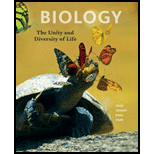
Concept explainers
A heterozygous individual has a _______ for a trait being studied.
- a. pair of identical alleles
- b. pair of nonidentical alleles
- c. haploid condition, in genetic terms
Concept introduction: The pair of chromosomes where one of the pairs is of the maternal source and the other is of the paternal source that has genes in the same loci with variable alleles of the gene is called homologous chromosomes. The allele is the modification of the gene. The alleles are of two types, namely dominant and recessive.
Answer to Problem 1SQ
Correct answer: A heterozygous individual has a pair of nonidentical alleles for a trait being studied. Therefore, option b. is correct.
Explanation of Solution
Reasons for the correct statement:
Homozygous individuals have the same alleles on the gene loci either dominant homozygous or recessive homozygous. Heterozygous individuals have one dominant allele and one recessive allele. Thus, two different types of alleles of the same gene are present in the gene loci that are not identical to each other.
Option b. is given as “a pair of nonidentical alleles”
As heterozygous individuals possess different alleles of the same gene for the trait expressed, option b. is correct.
Reasons for the incorrect statements:
Option a. is given as “a pair of identical alleles”.
Homozygous individuals only have the same allele on both homologous chromosomes that is, the pair of identical alleles. Therefore, option a. is incorrect.
Option c. is given as “haploid condition, in genetic terms”.
Haploid condition refers to half the number of chromosomes. A heterozygous individual has two sets of chromosomes. Therefore, option c. is incorrect.
Hence, options a. and c. are incorrect.
Want to see more full solutions like this?
Chapter 13 Solutions
Biology: The Unity and Diversity of Life (MindTap Course List)
- In man, the allele for normal color (A) is dominant to the allele for albinism (a). A normal man whose father was albino married a normal woman whose mother was albino. a. What are the chances that their first child will be albino? b. What are the chances their second child will be albino?arrow_forwardMany genetic disorders are inherited in a recessive manner Select one: a. False b. Truearrow_forwardChromosomes undergo division during meiosis. Such chromosomal behaviors are consistent with Mendel's laws of a. Unit Characters b. None of these c. Dominance and Recessiveness d. Independent Assortment e. Secondary Nondisjunction Chromosomes undergo division during meiosis. Such chromosomal behaviors are consistent with Mendel's laws of a. Unit Characters b. None of these c. Dominance and Recessiveness d. Independent Assortment e. Secondary Nondisjunctionarrow_forward
- A trait that is present in a male child but not in either of his parents is characteristic of inheritance. a. autosomal dominant b. autosomal recessive c. X-linked recessive d. It is impossible to answer this question without more informationarrow_forwardA man with blood type A and a woman of blood type B have a baby girl of blood type O. The man sues his wife for divorce, on the grounds that it is not possible for the baby to be theirs (since the blood type is not A, B. or AB). Evaluate the lawsuit on the basis of genetics (A, B alleles are co-dominant over the recessive O allele). IA = A allele IB = B allele iO = O allelearrow_forwardA mother who is blood type a B has a child who is a B also. A potential father‘s blood type O. A geneticist concludes that. A. He cannot be the father B. He is very likely to be the father C. No conclusion can be drawnarrow_forward
- Tay–Sachs disease is caused by recessive alleles on anautosome. In which case(s) could two parents with anormal phenotype have a child with Tay–Sachs?a. Both parents are homozygous for a Tay–Sachs allele.b. Both parents are heterozygous for a Tay–Sachsallele.c. One parent is homozygous for a Tay–Sachs allele,and the other is heterozygous.arrow_forwardA man is brachydactylous (very short fingers; rare autosomal dominant), and his wife is not. Both can taste thechemical phenylthiocarbamide (autosomal dominant;common allele), but their mothers could not.a. Give the genotypes of the couple.If the genes assort independently and the couple hasfour children, what is the probability ofb. all of them being brachydactylous?c. none being brachydactylous?d. all of them being tasters?e. all of them being nontasters?f. all of them being brachydactylous tasters?g. none being brachydactylous tasters?h. at least one being a brachydactylous taster?arrow_forwardTwo parents without cystic fibrosis have a child with cystic fibrosis. The allele for cystic fibrosis is therefore _________ to the non-disease allele Group of answer choices A. codominant B. recessive C. dominant D. epistatic E. incompletely dominantarrow_forward
- Mendel’s crossing of round-seeded pea plants with wrinkled-seeded pea plants resulted in progeny that all had round seeds. This indicates that the wrinkled-seed trait is Select one: a. rare b. abnormal c. dominant d. codominant e. recessivearrow_forwardWebbed fingers is inherited as an X-linked disease An unaffected male marries an affected female. a. Draw a Punnett square of the possible offspring. b. List the phenotypes of the possible children c. Draw a pedigree that displays the inheritance in you Punnett squarearrow_forwardShaded individuals in this pedigree express a particular trait. Based on this pedigree, what is the mode of inheritance of the trait? O A. autosomal dominant O B. autosomal recessive OC sex-linked dominant D. sex-linked recessivearrow_forward
 Biology Today and Tomorrow without Physiology (Mi...BiologyISBN:9781305117396Author:Cecie Starr, Christine Evers, Lisa StarrPublisher:Cengage Learning
Biology Today and Tomorrow without Physiology (Mi...BiologyISBN:9781305117396Author:Cecie Starr, Christine Evers, Lisa StarrPublisher:Cengage Learning
